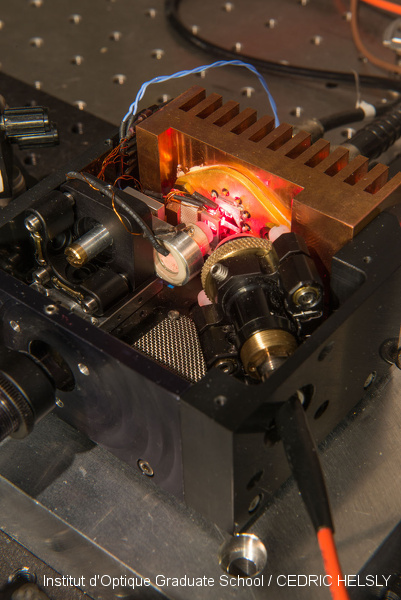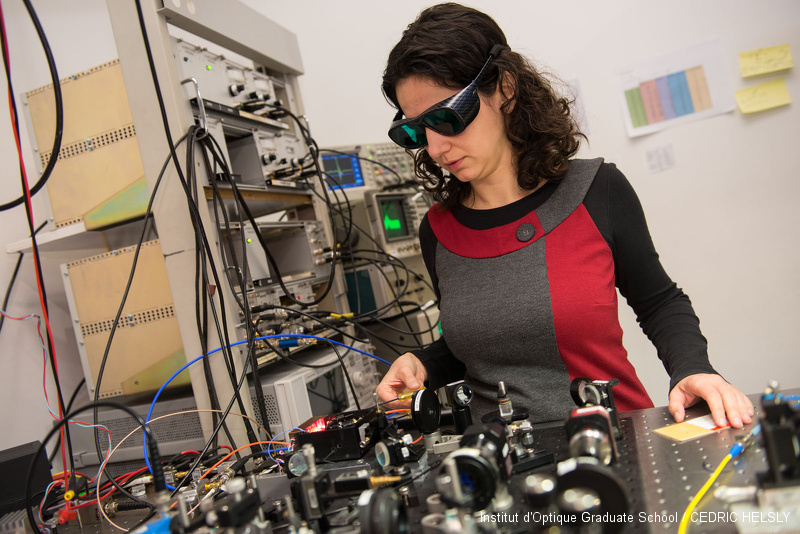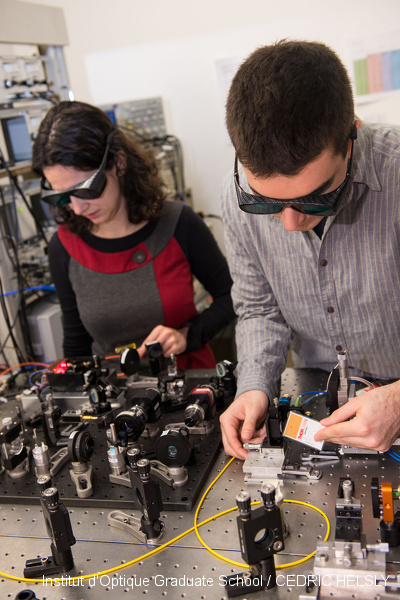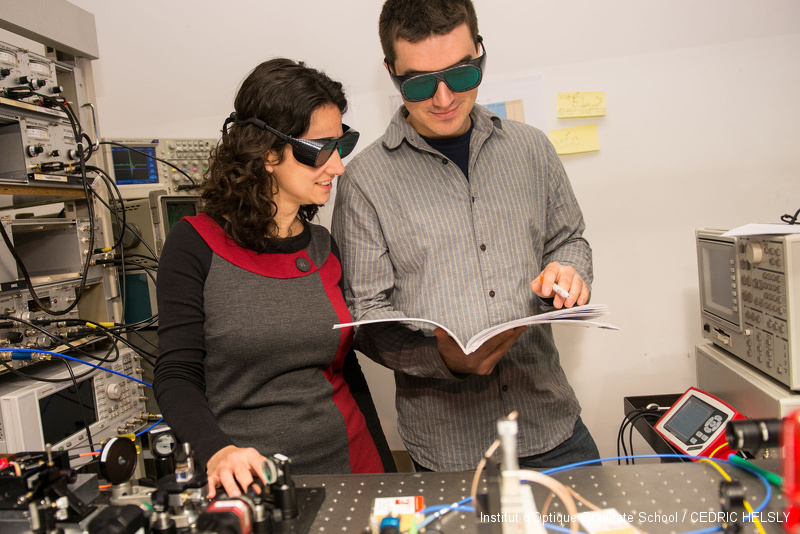Archives : Ressources
Ressources et documentation
SPECTROSIM : simulateur de l’interaction entre un atome à deux niveaux et un rayonnement
SPECTROSIM est un programme informatique servant à simuler l’interaction entre un atome à deux niveaux et un rayonnement. Pour chaque jeu de paramètres, il fournit la courbe montrant les variations de la probabilité de transition entre les deux niveaux atomiques en fonction de la fréquence du rayonnement et un ordre de grandeur de la stabilité de fréquence. Il est principalement destiné à la formation (ou à la médiation scientifique).
=> Accès gratuit au logiciel : http://www.first-tf.fr/spectrosim/
26th General Conference on Weights and Measures (CGPM)
The 26th General Conference on Weights and Measures (CGPM) took place in Versailles in November 2018. At this meeting, the CGPM to approved a resolution to revise the definitions of the International System of Units, the SI, which is based on the second, the metre, the kilogram, the ampere, the kelvin, the mole and the candela (the SI base units).
Over the last 50 years, scientists have measured constants of nature, such as the speed of light and the Planck constant, with increasing accuracy; indeed the metre was already redefined back in 1983 in terms of the speed of light. The inherent stability of these constants make them ideal for underpinning new definitions of the SI units and preparing the measurement system to meet the future demands of science and technology.
The SI will be based on seven physical constants, and thus inherently stable. Most notably, this will mark the end of the last remaining physical artefact in the SI system – a cylinder of metal known as the International Prototype of the Kilogram.
The work needed to reach this point has taken many years, and has been a truly international effort. The universality of access that it will afford has been a long-standing goal for the metric system, dating back more than 200 years.
=> More d’information.
Laser bifréquence
Un prototype de laser bifréquence a été développé dans le cadre de l’ANR 2POLEVF, et réalisé au SYRTE. La longueur de la cavité laser est de 10 mm, elle comporte des composants biréfringents (lame séparatrice de polarisation, cristal électro-optique) et un étalon. La source de pompage est une diode laser fibrée à 670 nm. Le dispositif est très compact (90 x 90 x 40 mm^3).
Le projet illustré ici a bénéficié d’un soutien de FIRST-TF.

http://phototheque.institutoptique.fr/picture.php?/7911/category/352
Laser bifréquence
Fabiola Camargo et Paul Dumont ont travaillé ensemble au LCF à la réalisation et la caractérisation d’une source laser bifréquence pour une horloge atomique utilisant le piégeage cohérent de population (CPT), développée dans le cadre du projet ANR 2POLEVF (collaboration C2N, LAC, LCF, SYRTE, TRT). La source est un laser à semiconducteur en cavité externe (VECSEL) pompé optiquement par une diode de puissance à 670 nm. Le banc optique permet d’asservir la fréquence absolue du laser sur une transition atomique du Cs, et la différence de fréquence sur un oscillateur local.
Le projet illustré ici a bénéficié d’un soutien de FIRST-TF.

http://phototheque.institutoptique.fr/picture.php?/7913/category/352
Laser bifréquence
Fabiola Camargo et Paul Dumont ont travaillé ensemble au LCF à la réalisation et la caractérisation d’une source laser bifréquence pour une horloge atomique utilisant le piégeage cohérent de population (CPT), développée dans le cadre du projet ANR 2POLEVF (collaboration C2N, LAC, LCF, SYRTE, TRT). La source est un laser à semiconducteur en cavité externe (VECSEL) pompé optiquement par une diode de puissance à 670 nm. Le banc optique permet d’asservir la fréquence absolue du laser sur une transition atomique du Cs, et la différence de fréquence sur un oscillateur local.
Le projet illustré ici a bénéficié d’un soutien de FIRST-TF.

http://phototheque.institutoptique.fr/picture.php?/7921/category/352
Laser bifréquence
Fabiola Camargo et Paul Dumont ont travaillé ensemble au LCF à la réalisation et la caractérisation d’une source laser bifréquence pour une horloge atomique utilisant le piégeage cohérent de population (CPT), développée dans le cadre du projet ANR 2POLEVF (collaboration C2N, LAC, LCF, SYRTE, TRT). La source est un laser à semiconducteur en cavité externe (VECSEL) pompé optiquement par une diode de puissance à 670 nm. Le banc optique permet d’asservir la fréquence absolue du laser sur une transition atomique du Cs, et la différence de fréquence sur un oscillateur local.
Le projet illustré ici a bénéficié d’un soutien de FIRST-TF.

http://phototheque.institutoptique.fr/picture.php?/7921/category/352
GPS : quelques aspects de physique
Agrégation externe de physique-chimie option physique
Problème de physique 2017 : sujet et corrigé
« Quelques aspects de la physique du GPS »
L’objectif de ce problème est d’étudier quelques-uns des principaux facteurs intervenant dans la mesure et d’en déduire des contraintes sur le fonctionnement d’un système opérationnel.
http://agregation-physique.org/images/annales/2017/ppc17.pdf
La fabrique du temps
Il y a cinquante ans, le 13 octobre 1967, la seconde, unité de mesure du temps, était définie non plus par les astres mais par les atomes. Dans cette quête de la précision, les scientifiques inventent aujourd’hui les horloges du futur, qui permettront non seulement d’exprimer le temps avec encore plus de finesse, mais de revisiter les lois fondamentales de la physique.
The economic impact on the UK of a disruption to GNSS
Like all modern economies, much of everyday life in the UK is reliant on Global Navigation Satellite Systems (GNSS). It is sometimes called the invisible utility.
GNSS provide signals from satellites orbiting in space to give us accurate information on positioning, navigation and timing. These systems have a large range of uses but, until now, the economic benefits haven’t always been well understood. It is not clear what the economic impact of a GNSS outage would be on the UK.
This report looks at what would happen to the UK economy if GNSS were unavailable for 5 days.
https://www.gov.uk/government/publications/the-economic-impact-on-the-uk-of-a-disruption-to-gnss
The Impact of quantum technologies on the EU’s future policies: Part 1 Quantum Time
Atomic clocks are a quantum technology, used in national metrology laboratories to define UTC and in various networked infrastructure. Developments in the clocks themselves, and in the distribution of precise time, can be expected to affect several application areas of importance to European policy.
